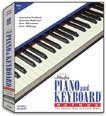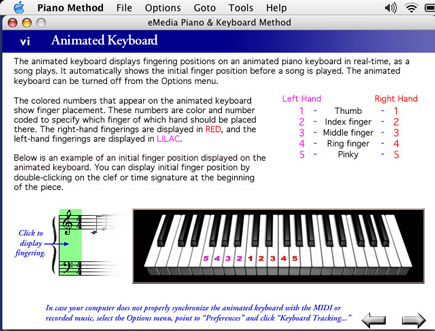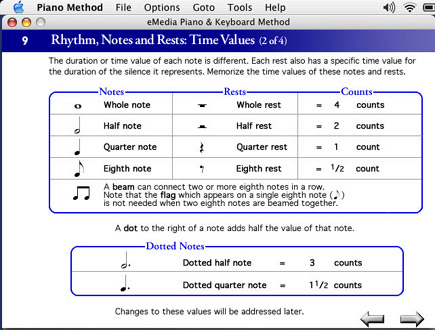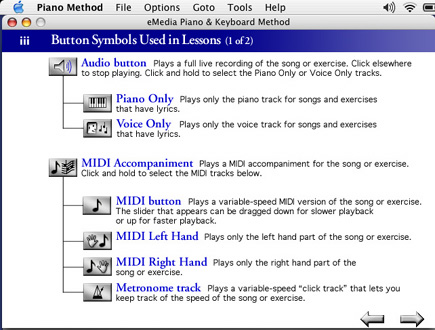
eMedia Piano and Keyboard Method, Volume One
Company: eMedia Music
Price: $60 (software only — MIDI keyboard available for additional cost)
I’ve been teaching guitar, piano, and music theory for over forty years, with a technique I developed and refined along the way. eMedia Music uses traditional methods and pedagogy to achieve successful results for students who stick to its curriculum. If I had learned via the eMedia system, I would be a superior pianist, and I intend to incorporate many of the company’s procedures into my tutoring.
The software is comprehensive, well-designed, and easy to use. Installation and operation are effortless. The application and its supporting media files on CD quickly shift into the background as you concentrate on becoming a keyboard musician. In OS X, 38MB is installed, and in OS 9 the total is 56MB, while the CD contains over 500 MB of data and music and video snippets.
Four major units contain a total of 160 individual chapters, many of which have audio and/or video tutorial enhancements. Every multimedia example works perfectly, and a lot of care went into their production. A thorough, no nonsense approach permeates eMedia Piano and Keyboard Method, and its written material, clickable button links, and program options are easy to master.
I received a MIDI keyboard that I didn’t use on this review. Even without an attached keyboard, I was able to use the tutorials on my iBook placed alongside either my Casio portable keyboard or my Technics professional studio digital electronic grand piano.

eMedia’s animated screen keyboard is a personal favorite, alongside song highlighting, looping, and adjusting via a sliding-scale metronome. The company reminds users again and again to observe healthy sitting and finger positions, which I applaud.
Ear training examples are less extensive or engaging than on the recently-reviewed Hearing Music by Morton Subotnick, but they suffice. Mini-quizzes assist students in testing their heard responses, but there is a slight navigational annoyance when going from quiz back and forth to instructional text. I’ll mention it to the company’s software engineers.
Following a lengthy multi-lesson introduction to the keyboard, “Mary Had a Little Lamb†is introduced in lesson 24. The first batch of sample songs is old-fashioned and a bit too “square†for my taste, but the tunes are consistent with traditional methods of piano instruction (yawn).

After thirty short chapters of basics, in the second major unit we learn about the staff, the clefs, note names, and middle C. My scribbled comments during the study of this bunch of lessons are:
• thorough instructional detail
• corny musical examples
• outstanding production values
• easy to navigate most of the time
• generous inclusion of French language songs.
Pages can be printed via a Menu Bar command, and other options include a display of guitar chords in addition to piano notes. I was unable to access the application’s Help Menu, so I’ll need to check with eMedia to see if the problem was mine or theirs. Once you’ve spent an hour using the software, you probably won’t need much help anyway.
At lesson 48, we encounter Beethoven’s mighty “Ode to Joy,†and the song quality improves from then onward. The MIDI options within the software allow users to choose MIDI sounds and metronome speeds — a very nice enhancement.
When comparing this Piano and Keyboard Method to the aforementioned product from Viva / Subotnick (they are not really competitors) I’m struck by how effective are the cartoons in Hearing Music, and how visually dry are the eMedia screens. But P&KMethod’s quantity of detail and repetitive reinforcement present the material in a way that has produced results through generations.

I chuckled during the vocal rendition of “When the Saints Go Marching In†at lesson 54. The singer is more operatic than bluesy, which defeats the gutsy quality of the song but would not disturb someone less fussy, or unfamiliar with this soulful tune.
Particular praise goes to eMedia for its clean software. I’m testing their Piano and Keyboard Method on an ancient blueberry G3 iMac running (I should say crawling through) OS X Panther, and the keyboard lessons are immediately responsive to my clicking, scrolling, and mousing.
Being Volume One, I have high marks for the b-a-s-i-c information on ear and hand and staff and scale training that appears in lesson 63. Most students avoid learning this stuff until they are forced to do so, and a gentle stressless primer is sufficient at this point in keyboard instruction.
Near the end, a rendition of “Minuet in G†has a pleasant, straightforward arrangement (simple = good, for new pianists!). Scott Joplin’s “The Entertainer,†following soon after, is presented in a way that users will be able to read the music and play it sooner than later, especially with help from the sliding metronome.
A ton of top quality work went into the creation of eMedia Piano and Keyboard Method, Volume One, in spite of my preference for somewhat less conventional musical examples and traditional instructional methods. By the time users are told: “Congratulations — You have finished the course,†they will have gone from newbie to advanced beginner in as painless a way as possible for a self-instruction technique. MyMac.com looks forward to Volume Two, and we award this initial effort a very strong 4 out of 5 rating.

Leave a Reply
You must be logged in to post a comment.